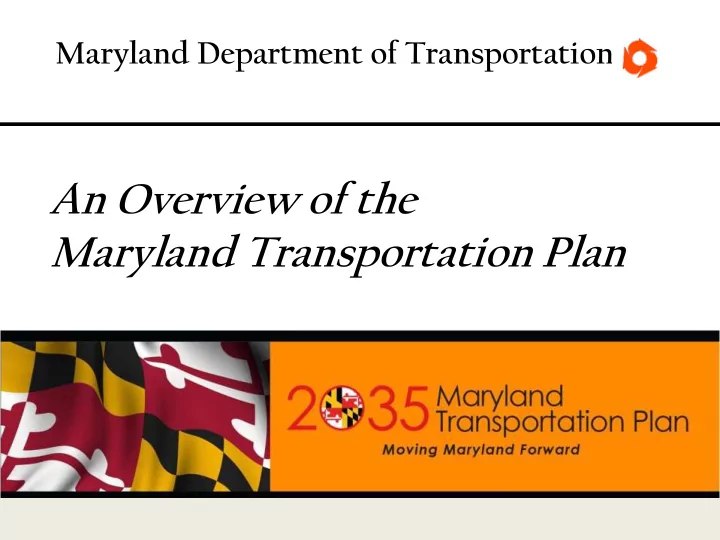

Maryland Department of Transportation An Overview of the Maryland Transportation Plan
What is the MTP? What is the MTP? A 20-year vision for transportation in Maryland that outlines the State’s transportation policies and priorities and helps guide Statewide investment decisions for all methods of transportation • Last published in 2009. • Updated every 4-5 years per federal/state requirements. • Establishes a 20-year vision, goals, objectives and strategies for MDOT. • 20-year forecast of State transportation needs based on the financial resources anticipated to be available. • Includes a summary of the types of projects, programs and strategies to achieve goals and objectives. • Bicycle/Pedestrian Master Plan is being updated at the same time and will be a companion element to the MTP. www.mdot.maryland.gov/mtp
What is the MTP’s Function? • Establish a Vision for Transportation in Maryland • Inform Project Selection • Provide Accountability/Establish Expectations 3
Context Setting The MTP provides a planning context that responds to a broad set of issues, challenges, law and existing plans and policies. 4
Master Pedestrian & Bike Plan
PlanMaryland, GreenPrint, AgPrint, & Housing Framework
Regional Plans Consider Plans of the State’s Metropolitan Planning Organizations
Maryland Planning Visions (2009) 1. Quality of Life and Sustainability: A high quality of 7. Housing: A range of housing densities, types, and sizes life is achieved through universal stewardship of the provides residential options for citizens of all ages and land, water, and air resulting in sustainable incomes; communities and protection of the environment. 8. Economic Development: Economic development and natural 2. Public Participation: Citizens are active partners in resource – based businesses that promote employment the planning and implementation of community opportunities for all income levels within the capacity of the initiatives and are Sensitive to their responsibilities in State’s natural resources, public services, and public facilities achieving community goals. are encouraged; 3. Growth Areas: Growth is concentrated in existing 9. Environmental Protection: Land and water resources, population and business centers, growth areas including the Chesapeake and coastal bays, are carefully adjacent to these centers, or strategically selected new centers. managed to restore and maintain healthy air and water, natural systems, and living resources; 4. Community Design: Compact, mixed – use, walkable design consistent with existing community character 10. Resource Conservation: Waterways, forests, agricultural and located near available or planned transit options areas, open space, natural systems, and scenic areas are is encouraged to ensure efficient use of land and conserved; transportation resources and preservation and 11. Stewardship: Government, business entities, and residents enhancement of natural systems, open spaces, are responsible for the creation of sustainable communities recreational areas, and historical, cultural, and by collaborating to balance efficient growth with resource archeological resources. protection; and 5. Infrastructure: Growth areas have the water 12. Implementation: Strategies, policies, programs, and funding resources and infrastructure to accommodate for growth and development, resource conservation, population and business expansion in an orderly, infrastructure, and transportation are integrated across the efficient, and environmentally sustainable manner; local, regional, state, and interstate levels to achieve these 6. Transportation: A well – maintained, multimodal Visions. transportation system facilitates the safe, convenient, affordable, and efficient movement of people, goods, and services within and between population and business centers;
MAP-21 (Federal Policy Guidance) • Seven MAP-21 National Goal Areas • Twelve MAP-21 National Performance Measures – States required to establish performance targets – LRP and STIP must incorporate National Performance Measures and targets
PlanMaryland Geographies Assess appropriate typology for investments w/ respect to planned growth areas
Critical Challenges Safety for All Users Aging Transportation System Assets New Technologies for Transportation Changing Demographic, Economic and Travel Patterns Supporting Community Quality of Life and Wise Land Use Choices Managing Congested Infrastructure Building Foundations for Economic Prosperity Assuring Environmental Quality 11
Trip Reliability 12
2035 MTP – Outline • State of the System • Regional Focus: • Critical Challenges Western MD Washington Metro Region • Needs Baltimore Metro Region • Public input Southern MD • Mission/Vision/Goals Eastern Shore • Strategies • Use of Transportation • Short term exemplar “Place types” projects
MTP Goals 1. Safety & Security - Enhance the safety of transportation system users and provide a transportation system that is resilient to natural or man-made hazards 2. System Preservation - Preserve and maintain the State’s existing transportation infrastructure and assets 3. Quality of Service - Maintain and enhance the quality of service experienced by users of Maryland’s transportation system 4. Environmental Stewardship - Ensure that the delivery of the State’s transportation infrastructure program conserves and enhances Maryland’s natural, historic, and cultural resources 5. Community Vitality - Provide options for the movement of people and goods that support communities and quality of life 6. Economic Prosperity - Support a healthy and competitive Maryland economy
Transportation Place-Types • Transportation and land use planning are inter-related. • The MTP uses GreenPrint and AgPrint geographies, and builds on PlanMaryland by establishing place-types to recognize differences and outlines transportation solutions appropriate to the varied needs and settings around the state. • The MTP divides the State by region and by place type. • There are 4 types of places that have special concern for transportation infrastructure decisions, these are: – Urban Centers – Towns and Suburban Centers – Rural & Agricultural Areas – Natural Areas
Maryland’s Five Regions
Regional Mapping & Strategies
Regional Mapping & Strategies
Regional Mapping & Strategies
Regional Mapping & Strategies
Regional Mapping & Strategies
MTP Process & Schedule • Winter 2013: – Initiate Public Outreach Activities (E-list, Survey, Stakeholder Meetings, Newsletters, Presentations, etc.); – Assess Current Conditions and Trends; and – Develop Draft Goals, Objectives, Strategies and Performance Measures. • Spring 2013: – Identify Potential Strategies; – Assess Qualitative Needs and Financial Resources; and – Host Advisory Committee Meetings to Discuss Performance Measures. • Summer 2013: Develop the Draft 2035 Plan • Fall 2013: Public Outreach on Draft Plan • January 2014: Release 2035 MTP
Recommend
More recommend